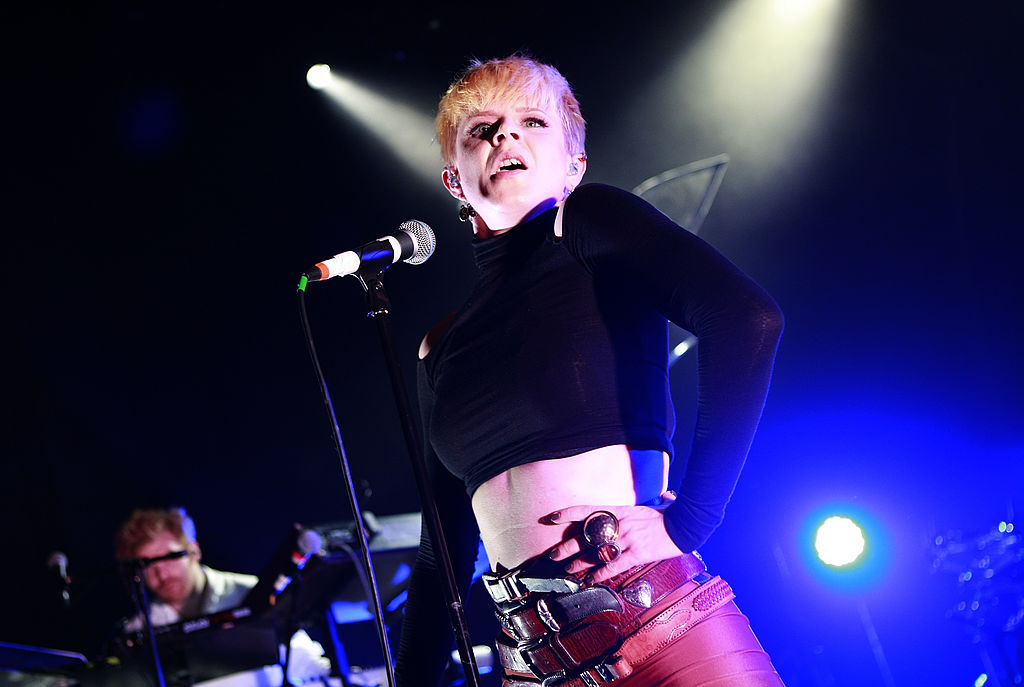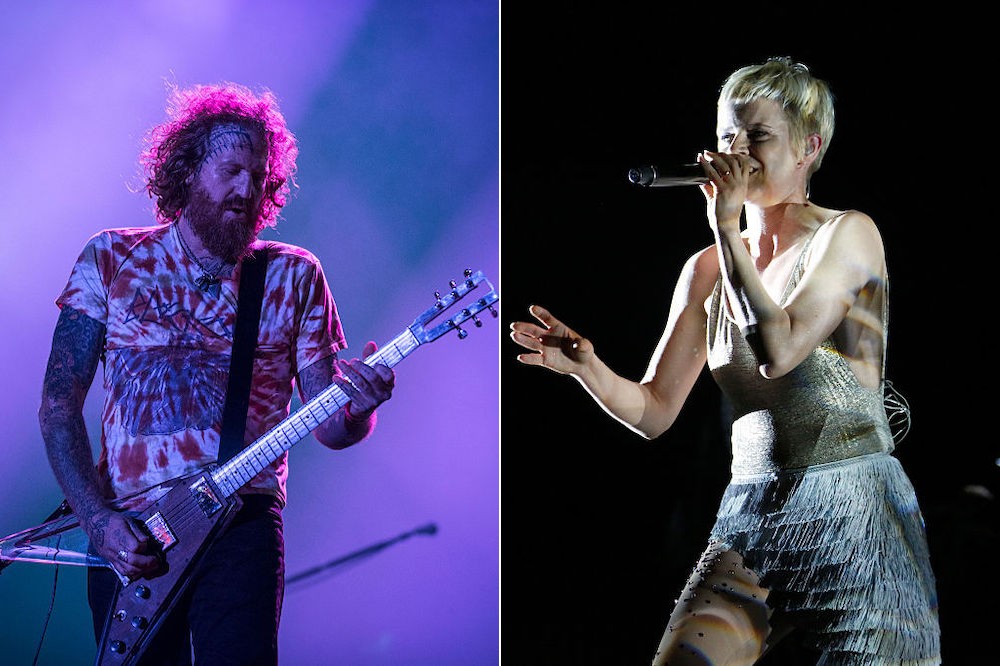This piece originally appeared in the November 2010 issue of SPIN.
For several bizarre hours on a Tuesday afternoon in September, Swedish pop star Robyn attends a cocktail party for Manhattan socialite Blair Waldorf. The event, of course, is as fake as the plastic strawberries stacked next to the chocolate fountain—they’re shooting a scene from an episode of Gossip Girl—and the 31-year-old singer born Robin Carlsson lip-synchs to a stripped-down version of her latest single, “Hang With Me,” as extras grip champagne glasses inside Silvercup Studios in Queens and try to look posh.
“Do you have artists here a lot?” Robyn asks a trio of staffers who have gravitated to her dressing rom. The answer comes quickly—Lady Gaga and No Doubt (and, um, Sonic Youth)—which means Robyn is the third platinum-haired pop star to perform on the show, but the first without a platinum album. This century, anyway.
In 1998, she was a New York-based teen ingénue with a smash single, “Show Me Love,” cowritten by Britney Spears/Backstreet Boys hitmaker Max Martin. But in 1999, the same year Spears slapped on a schoolgirl outfit for “…Baby One More Time,” Robyn flipped off the industry and remade herself into a DIY electro queen. More than a decade later, the gamble is paying off: Robyn makes music she likes—shimmering melodic disco that’s equally suited for losing yourself on a dance floor or in your thoughts– and the overwhelmingly positive response to her latest albums, Body Talk Pt. 1 and Pt. 2, which hit the Top 10 on the iTunes albums chart and led to a performance on MTV’s Video Music Awards.
“I didn’t expect this,” Robyn admits between scenes as she reaches into a black fanny pack for a Marlboro Light. Sitting on a bench near the stage’s loading dock, she’s wearing a gray sweatshirt with a torn out neck, Flashdance-style, protecting her Gossip Girl wardrobe of red top and puffy black skirt, exuding the casual confidence of someone who’s been onstage her whole life. Her parents ran an experimental-theater group in Stockholm, and traveling with them exposed her to club culture and progressive artists such as Laurie Anderson at an age most kids are grappling with Sesame Street; by 12, she had been discovered singing at school. “Being onstage and communicating with an audience was part of my life since I was very little, but I was never pushed into singing,” she says. “My parents were so uninterested in me making music. They were just like, ‘Do whatever you gotta do.’”
Martin and the late Swedish producer Denniz Pop oversaw her blockbuster 1997 debut, Robyn Is Here. Being around these songwriters was a huge influence on her, as was the eclectic pop on European radio in the ‘90s. “You’d hear Guns N’ Roses and Snap! and N.W.A,” she says. “We’d have to make our own ways to connect them.”
While “Show Me Love” and “Do You Know (What It Takes)” were hits in America, Robyn’s passion was fading fast. “I was having fun, but it wasn’t my dream come true,” she says with a slight accent. “When you’re 17 and you have an idea, people don’t really listen to you. I came out of an environment where my parents were always pushing me to do what I wanted and be creative, and I was not used to the industry’s way of thinking.”
She returned to Sweden and put out two albums that weren’t released outside of Europe, then experienced her Moses-on-the-mountain-top moment once she realized she could simply do it herself. “I’d always been a club kid so I was totally unaware that people had their own record companies,” she says over Gossip Girl’s lunch break, gulping down a plate of salad, rice and beans, and salmon in the studio’s commissary.
She recorded her next disc, Robyn, for her own Konichiwa Records. “There was no A&R, no expectations, no one to answer to”—an ideal scenario for someone who’d later write a throbbing tune called “Don’t Fucking Tell Me What to Do.”
A mix of finger-wagging hip-hop boasts, glitchy pop, and lovelorn reveries, Robyn came out in Sweden in 2005 and didn’t make its way to the U.S. until three years later. But by the time Robyn signed a distribution deal with Interscope and returned for her first U.S. show in a decade, a funny thing happened: The Internet quietly spread Robyn to an unlikely new audience of tastemakers. “Sure the Internet is the future, but what we do on the Internet is still very primal,” Robyn says. “It’s all about connecting to other people, sharing emotion. It’s our new feathers or face paint. It’s all very raw. I think the contrast between those things is what’s really inspired this new album.”
***
The three-part Body Talk (Pt. 3 is out this month, just in time for a U.S. tour) is Robyn’s most expansive work yet, but don’t read too much into the construct—Coheed and Cambria this ain’t. “It’s a practical solution, not a conceptual idea,” she explains, and the staggered release allows her to mix touring with studio sessions, so she’s never away from one for too long. “Plus, people go on the Internet and find the music they want,” she says. “It’s not about major labels pushing five records through the same channels and telling, “This is what you should like this year.’ As an artist, you look stupid if you don’t recognize the new structure.”
Pt. 1 distills Robyn’s romance with technology into “Fembot,” where she paints herself as an extremely sexy android. But the album’s centerpiece is “Dancing on My Own,” an emo-electro empowerment anthem about watching an ex kiss his new girl that’s a sequel of sorts to Robyn’s weepy fan favorite “With Every Heartbeat.” “I like sad songs; it’s just such a pure and classic pop emotion,” Robyn says, citing Prince’s “Purple Rain.” (Despite her penchant for lyrics about heartbreak, she has been in a relationship with top Swedish MMA fighter Olof Inger for the past eight years.) “Lovesickness is the most extreme version of being an outsider or not feeling understood or loved,” she says. “It’s a universal feeling everybody connects to.”
Like her sister-divas Gaga and Madonna, for whom Robyn opened on the European leg of last year’s Sticky & Sweet tour (“I got to be in one of her preshow circles when they’re all hugging—we were in Athens, so she was talking about Greek culture”), Robyn banks on dance music’s ability to bring together a diverse audience. She considers hers to be “35-year-old white males, hipsters, badonkadonk girls from Brooklyn, goths, and nerdy kids.” But not exclusively. “I love her music,” Madonna tells SPIN. “She’s a great songwriter and a very cool girl.”
“If you’re an outsider, you can always find a club where there’s other people feeling the way you do,” Robyn says. But all this goes deeper than disco—unlike most current pop stars, who grab tracks from whichever producer has the hottest goods, Robyn sticks with a few trusted collaborators and tours with the live band that includes two drummers. “I knew there was a way of doing pop songs that felt organic,” she says. Still, the mounting buzz and adulation surprises her. “[Body Talk] is a dance record and people look down on dance music here,” she says, shrugging. “I didn’t expect it to do anything.”
With a few minutes left to close her eyes before her next scene, she heads toward her dressing room. “If you can write good songs,” she says, flicking a cigarette to the ground, “you can dress them in anything.”
***
Dressing up is definitely the theme of the day.
A few hours after wrapping on Gossip Girl, Robyn changes into a white dress and heads over to a real hoity-toity party, a four-floor Fashion Week bash for Vogue’s website. Big-name designers like Zac Posen glide around and pose for photographers while a DJ blasts Jamiroquai and Jay-Z. But when Robyn cuts through the crowd to join her keyboardist Marcus for a stunning, subdued four-song acoustic set, camera phones light up like the mock New York skyline she’d left behind on the Queens soundstage. “With Every Heartbeat,” naked without its synth pulse, still holds the room rapt, and fashionistas and waiters pack in shoulder to shoulder to get a better view.
If there’s anything Robyn’s self-imposed retreat taught her, it’s that none of this attention should be taken seriously or for granted. As a result, her brand of blonde ambition is maybe more measured than than that of some of her peers.
“Whatever happens is good,” she’d said earlier, smiling. “If I just get to do my music and make enough to pay rent, I’m fine.”





